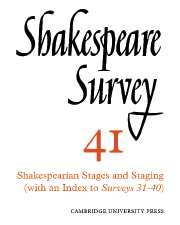Book contents
- Frontmatter
- The Shakespearian Stages, Forty Years On
- The Original Staging of The First Part of the Contention (1594)
- Charles Calvert’s Henry V
- Hamlet, An Apology for Actors, and The Sign of the Globe
- ‘Hid indeed within the centre’: The Hall/Finney Hamlet
- Malvolio and the Dark House
- The Text of Cressida and Every Ticklish Reader: Troilus and Cressida, The Greek Camp Scene
- Antony and Cleopatra, Act 4 Scene 16: ‘A Heavy Sight’
- The Tempest’s Tempest at Blackfriars
- Keats and Lucrece
- The Resources of Characterization in Othello
- Ovid and the Mature Tragedies: Metamorphosis in Othello and King Lear
- The Passing of King Lear
- Shakespeare Performances in London and Stratford-upon-Avon, 1986–7
- Professional Shakespeare Productions in the British Isles, January–December 1986
- The Year's Contributions to Shakespeare Studies: 1 Critical Studies
- 2 Shakespeare’s Life, Times, and Stage
- 3 Editions and Textual Studies
- Books Received
- Index to Volume 41
- General Index to Volumes 31-40
Antony and Cleopatra, Act 4 Scene 16: ‘A Heavy Sight’
Published online by Cambridge University Press: 28 March 2007
- Frontmatter
- The Shakespearian Stages, Forty Years On
- The Original Staging of The First Part of the Contention (1594)
- Charles Calvert’s Henry V
- Hamlet, An Apology for Actors, and The Sign of the Globe
- ‘Hid indeed within the centre’: The Hall/Finney Hamlet
- Malvolio and the Dark House
- The Text of Cressida and Every Ticklish Reader: Troilus and Cressida, The Greek Camp Scene
- Antony and Cleopatra, Act 4 Scene 16: ‘A Heavy Sight’
- The Tempest’s Tempest at Blackfriars
- Keats and Lucrece
- The Resources of Characterization in Othello
- Ovid and the Mature Tragedies: Metamorphosis in Othello and King Lear
- The Passing of King Lear
- Shakespeare Performances in London and Stratford-upon-Avon, 1986–7
- Professional Shakespeare Productions in the British Isles, January–December 1986
- The Year's Contributions to Shakespeare Studies: 1 Critical Studies
- 2 Shakespeare’s Life, Times, and Stage
- 3 Editions and Textual Studies
- Books Received
- Index to Volume 41
- General Index to Volumes 31-40
Summary
Just how did Shakespeare intend the dying Antony to be raised to Cleopatra in her monument? By what means? By whom? How high? To where? Was there a balustrade to get him over? Was there a window to get him through? These questions have long puzzled theatre historians, and a variety of ingenious answers has been offered.1 The text has become a basis for speculation on the physical characteristics of the Globe Theatre both because of and despite the fact that it provides no direction other than: 'They heave Antony aloft to Cleopatra (4.16.38.1). While it is usually assumed that more explicit stage directions are missing, it is also possible that what we have is sufficient and an indication that Shakespeare knew what he wanted and how it would be done. Certainly, given his theatrical experience, it is most unlikely that he would have created staging problems requiring complex and therefore expensive and restrictive solutions.
Emendations and additions proposed by most modern scholars are made in the belief that without them the raising of Antony would be disconcertingly and unsuitably awkward. Perhaps, however, we should consider whether Shakespeare intended exactly this effect, and we should begin by asking not 'how' but 'why' Antony is raised aloft.
- Type
- Chapter
- Information
- Shakespeare Survey , pp. 77 - 90Publisher: Cambridge University PressPrint publication year: 1989



